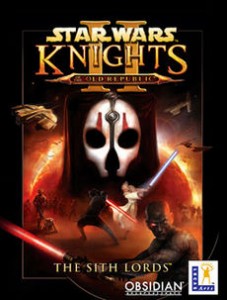379th played so far
 Genre: Role-Playing
Genre: Role-Playing
Platform: PC/Xbox
Year of Release: 2004
Developer: Obsidian Entertainment
Publisher: LucasArts
It’s been a while since we played Star Wars: Knights of the Old Republic. Since then, after it got to the top of the queue, I finished the game and thought it was time to try the sequel. As it, too, is on the list, that meant we had to cover it here too… Let’s see what it’s like.
Our Thoughts
While in some cases sequels can be samey or repetitive, using the same formula to continue the original, becoming weaker because it doesn’t get better, in others it can push the series further.
KotOR 2 is absolutely the latter. Although there are bigger gaps in the game due to pressure to finish the game earlier than Obsidian could deliver, it offers a better experience. One that explains why Obsidian is as respected as it is now. Although this is their first game, it was created by the people responsible for earlier respected games, like Planescape Torment and the original Fallout series.
The improvements are in a range of places. On the most basic level, the main character starting off as a Jedi, allowing you to focus on developing your character to follow that path, instead of having to split your development between a normal class and a Jedi class as in the first game. It feels a lot more satisfying and feels like there are less wasted points, abilities and feats. Beyond that, the list of powers and feats is expanded, giving you more options and things to play with, which is of course always fun.
An even clearer improvement, for me at least, is in the story telling. One of the big things that stood out to me was the storytelling (especially in the backstory) that happens through dialogue options, something I’ve rarely really seen. The player character has an existing backstory – where the character knows more than the player – and one of the ways it is shared is by mentioning it in the options you select. You can choose to mention (and this happens early, so isn’t really a spoiler) that you were a Jedi and were expelled from the order, but you can also skip the option and hide it. But knowing that you were one is enough information to go with. You get to explore more of it later in the game, but the way it sneaks in information that way is low-key and incredibly useful in telling you things without getting in your way as exposition. In a way, it shows how limited a dialogue wheel like Mass Effect‘s can be.
Another way it’s integrated is into the characters. In the first area you visit, pretty much the entire story is told through logs, bits of implied dialogue and some inferences you can make yourself – the full story gets told near the end, but you can work it out before then and easily piece bits together. It’s a lot more involved and a lot nicer than long cutscenes. More so, parts of this actually come through from the game mechanics. For example, at one point you need to use a droid’s ability to precisely replicate a now dead character’s voiceprint to get into a terminal. When you hack into it, you also notice it’s a terminal an order to kill some people has come from. You also discover it was sent after the owner of the terminal died.
There are probably more examples, but these show how well the story plays out, both for the main story and side quests. Absolutely engrossing, and simultaneously subversive enough that its grey was praised in the normally black and white world of Star Wars, although it was apparently less liked by its hardcore fanbase.
This is helped by the characters. While they were good in the first game, they feel enhanced here by having an added layer, some additional depth, with more of them going on than the archetypes that the first game featured. It’s mostly, again, a step up, but feels a bit better.
When it comes to technology, the game doesn’t feel like as much an improvement. The environments feel a bit improved and some of the models a bit nicer, but it’s a minor step up.
That’s minor, though. The game takes a large setting and makes it its own, telling a rich and complex story in a way that not many other games seem to accomplish. As much as it’s a clear sequel to the first Knights of the Old Republic, in the integration with the game, its sequel feeling from Planescape Torment seems just as important. And knowing what we know of a game like South Park: Stick of Truth, it seems like Obsidian may soon deserve another place on the list.
Final Thoughts
One thing that this game got me thinking about was the idea of canon. Since this game’s beginning spells out that the canon ending of the previous game was you betraying the Jedi and siding with the Sith the people at Star Wars HQ decided this game series was therefore not canon. Then they later started making a third trilogy of films which has made a lot of things that previously were canon non-canon.
I guess what I am trying to say is screw canon and just let Obsidian do what they do best.